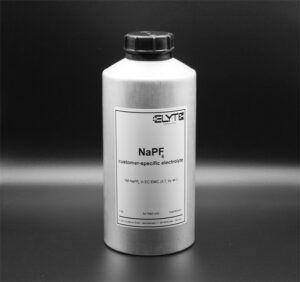The working principle of the sodium-ion battery
Sodium-ion batteries are devices that store energy by converting electrical and chemical energy into each other. The fundamental working principle is very similar to that of lithium-ion batteries, based on the reversible shuttling of ions between two electrodes with the help of the electrolyte (“rocking chair mechanism”). A SIB consists of a positive (cathode) and negative (anode) electrode that are spaced apart by a separator, and an electrolyte. The latter contains a sodium salt dissolved in a suitable solvent mixture and enables the transport of sodium ions between the electrodes while being electronically insulated. Besides, ionic conductivity, the electrolyte must enable the formation of stable interphases at the electrode/electrolyte interfaces to prevent continuous electrolyte decomposition at high or low potentials. The electrolyte is in contact with several cell components, including current collectors, cell casing, the separator, and binders and, thus, must be compatible with all of them to achieve a long cycle life and high safety standards.
Step 1 – Initial state
A sodium-ion cell is typically assembled in the discharged state. The positive electrode is the sodium-ion source of the cell and contains the transferable sodium ions, whereas the negative electrode is sodium-free. Widely studied cathode materials are sodium transition metal oxides or Prussian blue analogs, and anode materials are typically disordered carbons (hard carbons).
Step 2 – SEI and CEI formation
During the initial charge, electrical energy is used to induce the migration of electrons from the positive electrode to the negative electrode via an external circuit. At the same time, the positive electrode releases sodium ions into the electrolyte to maintain charge neutrality. The sodium ions are transferred to the negative electrode through the electrolyte to be inserted there into the active material. Accordingly, an oxidation (positive electrode) and reduction (negative electrode) reaction take place at the respective electrode. The cell voltage increases as the cell is charged. The most used electrolyte components have a limited thermodynamical stability window and start to decompose at potentials above (positive electrode) or below (negative electrode) their electrochemical stability limits. As a result of the electrolyte decomposition, interphases are formed from decomposition products at the electrode/electrolyte interfaces, the CEI at the cathode and the SEI at the anode. The formation of these interphases is crucial for the functionality of the cell because they prevent continuous electrolyte degradation. To be efficient the interphases must be electronically insulating but highly sodium ion conducting.
Step 3 – Charge
With ongoing charging, more and more sodium ions are released from the cathode and stored in the anode via adsorption and intercalation mechanisms, thereby, the cell voltage gradually increases until a predetermined end of charge voltage is reached.
Step 4 – Discharge
During discharge, the movement of the electrons and sodium ions is reversed and occurs from the negative to the positive electrode. In this case, the oxidation reaction takes place at the negative electrode (anode), while the reduction reaction takes place at the positive electrode (cathode). The cell voltage decreases until the cell reaches a defined cut-off voltage.
Step 5 – Rocking chair mechanism
In each cycle, the sodium ions are shuttled from the positive to the negative electrode (charge) and back (discharge). A high reversibility of the ongoing storage processes and high electrolyte stability are of crucial importance for long cycle life.
